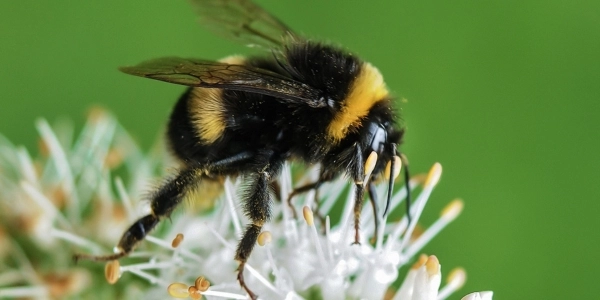When you see a bee flying around your house, you may have noticed that they’re not all created equally. From their appearance to their nesting habits, bumble bees, and black bees have several key differences that can help you tell them apart. It’s important to recognize these differences so that you know what type of pest you’re dealing with and how to control these insects around your home.
In this post, the professionals at Stomp Pest Control in Raleigh, NC are going to take you through the 5 main differences between black bees and bumble bees. Plus, we will answer some frequently asked questions so that you’ll be prepared when you encounter these pests around your home and yard.
5 Ways to Tell Black Bees Apart from Bumble Bees
Appearance
Black bees, or carpenter bees as they’re also called, are typically larger than bumble bees. They have a shiny black or blue color. Their abdomen is smooth and hairless and they have wings that appear iridescent in the sunlight.
Bumble bees are smaller in size and have a fuzzy abdomen with black and yellow stripes. Their fuzziness is instrumental when it comes to collecting and transporting pollen. The wings of a bumble bee are more translucent. Some types of bumble bees also have more markings or patterns on their bodies.
Behavior
Black bees are loners. They don’t live in colonies and don’t work together with other bees. They are known for boring holes into woods to create nests. This can create a great amount of damage as you can imagine.
Bumble bees are far more social. They live in colonies and have a hierarchy. There is a queen bee, female worker bees, and male drones. Bumble bee colonies are typically much smaller than honeybees, with only a few hundred in their colony. Bumble bees are known for their ability to fly in colder temperatures. This makes them important pollinators for early-blooming plants.
Bumble bees are known to be more aggressive than black bees, stinging repeatedly when they feel threatened. Bumble bee workers and queens are the only bees that will sting.
Nesting Habits
There are also differences in the nesting habits of black bees and bumble bees. Black bees create their nests by making holes in wooden structures of homes, and dead trees. They tend to look for wood that is soft or decayed. Once they have created their nest, the female carpenter bee can lay her eggs inside. Carpenter bees are known to reuse their nests year after year. The tunnels they create can lead to serious structural damage over time.
Bumble bees burrow underground. They do not typically cause damage, but they can be problematic when their nests are disturbed. The queen bumble bee will build a new nest each year so that the young bees emerge in the spring to start their new colony.
Diet
Both black bees and bumble bees are pollinators so nectar and pollen make up most of their diets. When bees collect pollen from flowers, they transfer some of this pollen to other flowers. This helps the plants to fertilize and reproduce.
Stinging Ability
Female bumble bees and black bees both have stingers. Female carpenter bees can sting when they feel as though their nest is in danger. Female bumble bees will sting if they are scared or upset. Remember bees are territorial creatures. If you don’t give them their space, they will likely sting you.
FAQ About Black Bees and Bumble Bees
Are black bees or bumble bees dangerous?
Neither black bees nor bumble bees are especially dangerous. But, they will protect their nests if they feel threatened. The main rule to remember is that if you don’t bother them, there’s less of a chance that they will bother you.
How can I prevent black bees near my home?
You can prevent black bees from invading the wood on your property by making sure all of your wood is painted or sealed. Any potential nesting sites should be filled to prevent black bees from getting near them.
You can also try to install physical barriers to prevent black bees from getting to your property. Screens or netting can often help to protect wooden structures.
Professional pest services from Stomp Pest Control can also help to prevent black bees and bumble bees from invading your home. If you notice a bee nest, it’s important to call as soon as possible so that your problem does not exacerbate.
How long does a honey bee live?
The lifespan of a worker bee is typically 6 weeks during the summer. Worker bees that live in the wintertime can live up to six months.
How long do carpenter bees live?
Carpenter bees can live for up to three years. They also produce 1-3 generations every year. The mother and her newly hatched daughters typically live in the nest.
Do carpenter bees make honey?
While carpenter bees pollinate flowering plants and feed on nectar, they do not produce honey.
How can you tell the difference between the different types of bumble bees?
A worker bee is the most common bumble bee you’ll see. The queen looks similar, but her abdomen is twice the length of a worker. This allows her to drop her abdomen into a honeycomb to lay an egg at the bottom. A drone bee is larger and fuzzier than a worker bee.
Need to Control Bees Near Your Home? Call Stomp Pest Control
If you think you have a black bee or honeybee infestation, call Stomp Pest Control. We can help protect your home against bees and the costly damage they can leave behind. Whether you’re looking for treatment for carpenter bees or bumble bees, we have you covered with affordable pest control packages starting at $25/month. You can count on our professional service to protect your home in the Raleigh area.
Experience the Stomp Difference today with a team of experts who will not only get rid of your pests but take action to prevent further infestations. Call us today at (919) 231-3292 or fill out the form below for a quote.
Contact Form
We would love to hear from you! Please fill out this form and we will get back to you shortly.



